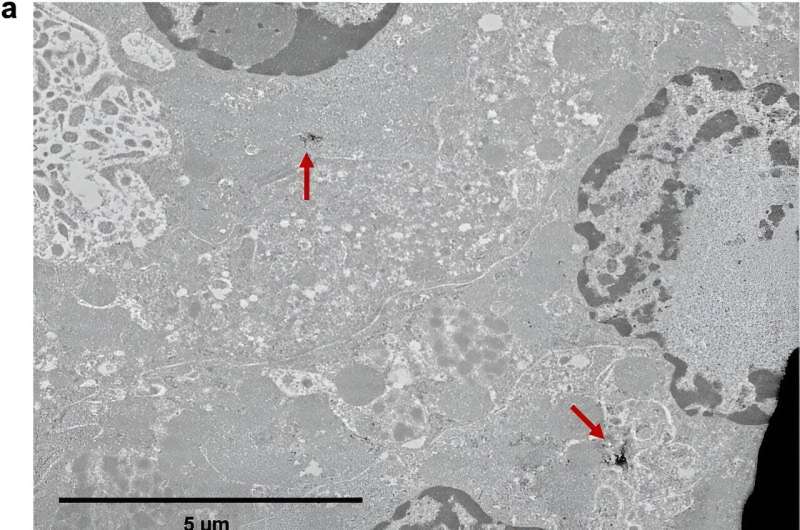December 12, 2023 report
This article has been reviewed according to Science X's editorial process and policies. Editors have highlighted the following attributes while ensuring the content's credibility:
fact-checked
peer-reviewed publication
trusted source
proofread
The top Medical Xpress articles of 2023

It was a good year for medical research as a team of toxicologists at Birjand University of Medical Sciences in Iran delved into the possible effects of cinnamon on memory and learning. In reviewing several past studies, they found that cinnamon and some of its active components could have positive effects on the functioning of the human brain, boosting memory and learning.
Last winter, a team of kidney specialists and health scientists at the University of New Mexico found that when gadolinium is used to enhance MRI scans, nanoparticles of the toxic rare earth metal can infiltrate kidney cells, sometimes triggering severe side effects. Under worst case scenarios, they found that such particles can trigger nephrogenic systemic fibrosis, a painful disease that affects the skin and organs and is often fatal.
Also, last winter, a team of biologists and nutritionists at Leibniz Institute for Food Systems Biology at the Technical University of Munich found that consumption of ginger can stimulate the immune system. They found during lab testing that the pungent plant, native to Southeast Asia, puts white blood cells on heightened alert approximately 30 to 60 minutes after consumption via mix with a tea, even at low concentrations.
And just a few months ago, a team of geneticists at Nemours Children's Hospital, in Delaware, working with colleagues from several other institutions in the U.S., found that babies born to mothers taking fentanyl while pregnant had similar physical deformities, such as short stature, small heads, deformed genitals and rocker-bottom feet. Many were also found to have facial deformities such as cleft palates. The researchers say the deformities were similar enough to suggest the emergence of a novel syndrome.
And last February, a team of neuroscientists determined that the naturally occurring dietary supplement known as nicotinamide riboside can enter the brain, raising NAD+ levels, which can alter the metabolism of relevant biological pathways involved in neurodegenerative diseases such as Alzheimer's.
And more recently, a team led by researchers from the Université Sorbonne Paris Nord and Université Paris Cité, France, after summarizing the scientific understanding of the adverse health effects related to consuming ultra-processed food, suggested that it was time to inform the public about the risks of such food.
Also, last winter, a team of researchers at Stanford University reported that people who engage in cyclic sighing breathing exercises see a greater reduction in stress than those engaging in mindfulness meditation and other stress reduction techniques. Tests with 114 volunteers also showed that most of them reported having more positive feelings using the technique than volunteers using other methods.
Last summer, a team of biochemists and neuroscientists at Trinity College of Dublin tested a theory that suggests forgetting is actually a form of learning. Test mice were induced to associate a specific object with a particular context or room and then to recognize that an object had been displaced from its original context. But they found that the mice forget these associations when competing experiences were allowed to interfere with the first memory.

Also last summer, a team of cell biologists, neurologists and geneticists at Rutgers and Emory Universities reported that mitochondrial dysregulation is a contributor to the development of schizophrenia. They found that when a small portion of chromosome 3 is missing—known as 3q29 deletion syndrome—it increases the risk for schizophrenia by about 40-fold.
Also, a team of medical investigators at Smidt Heart Institute at Cedars-Sinai found evidence that people feel gender-specific symptoms before an impending cardiac arrest—women most often experience shortness of breath during cardiac arrest, whereas men experience chest pain. The research team also found that half of such people also experienced a telling symptom up to 24 hours before their loss of heart function.
This past spring, two doctors, Robert Doyle and Christian Roth, presented findings regarding the use of drugs that mimic the changes in the body after gastric bypass surgery. They reported that some injectable compounds avoid the side effects of nausea and vomiting, which are common with current weight-loss and diabetes drugs, while remaining effective.
Also, an international team of medical researchers found an association between a cat-borne parasite and frailty in older adults. The parasite, Toxoplasma gondii, had already been associated with risk-taking behavior and mental illness in humans. They also noted that approximately 11% to 15% of people in the United States have been infected with the parasite at some point in their lives, with the highest rates among older adults.
And a team of aging and dementia specialists at the University of Queensland discovered that some mushrooms can magnify memory by boosting nerve growth. They found that the presence of active compounds N-de phenylethyl isohericerin in the mushroom Hericium erinaceus, which has been used in Asian countries for centuries, could stimulate nerve growth in lab rodent brains.
Also, this past summer, a team of researchers at NASA's Jet Propulsion Laboratory conducted tests to determine the maximum temperature and humidity conditions that humans can endure. Their work was aimed at learning more about human survival on other worlds, but also has implications for Earth as global temperatures continue to rise. They noted the critical limit, which occurs at 35°C after six hours of exposure, (and is known as the wet bulb temperature) has only been breached a couple of dozen times on Earth, but is likely to happen more often in the future.
And a team of pulmonary and critical care specialists at Northwestern University Feinberg School of Medicine found that cytokine storms did not kill COVID-19 patients over the course of the pandemic. Instead, secondary bacterial infection of the lungs led to deadly pneumonia. They also found that COVID-19 does not typically cause cytokine storms to occur in infected people. The researchers came to these conclusions by applying machine learning to medical records data.
Last month, a team of cardiovascular specialists and medical researchers noted that where and how you sit matters when getting your blood pressure taken at the doctor's office. They found that oftentimes, blood pressure is taken while the patient is seated on an examining table, leaving their legs to dangle and their back and arms unsupported. Such a position, they note, can lead to inaccurate readings and a misdiagnosis.
Last winter, a team of translational specialists at The Hospital for Sick Children in Toronto, Canada, found that changes in how the heart produces energy may be an early signal of cardiac deterioration. By analyzing a large dataset of information on gene expression in human hearts at later stages of heart failure, they found that a protein called lysine demethylase 8 was less active, allowing another protein called TBX15 to be more highly expressed, causing changes in metabolism.
And this past spring, a team outlined decades-long research involved in improving the resolution of MRI, resulting in the production of the sharpest images ever captured of a living mouse brain. A single voxel measured just 5 microns.
And over the summer, a team of biomedical technologists found that comparing super-agers to typical older adults revealed significant lifestyle and brain structure differences. Super-agers are people who do not experience normal age-related memory loss as they grow older.
And a team called the Task Force on Postovulatory Methods of Fertility Regulation found that the levonorgestrel emergency contraceptive pill was more effective when taken with the anti-inflammatory medication piroxicam after having unprotected sex. The pill, also known as the morning after pill, is often sold under the brand name Plan B. To be effective, it must be taken within 72 hours after having sex.
Last December, a team of doctors with Northwestern University's Department of Dermatology found that high doses of vitamin D alleviated symptoms for patients with toxic erythema of chemotherapy significantly faster than current treatments. Toxic erythema is a type of rash commonly seen in newborns, but it can also appear in patients receiving chemotherapy for treatment of cancer. It typically presents as patches on the hands and feet and can be painful.
Last September, a pair of world bank economists, Bjorn Larsen and Ernesto Sánchez-Triana, found that lead poisoning causes far more death and IQ loss than previously thought. They came to this conclusion by assessing the impact of lead exposure on heart disease deaths and child IQ loss in wealthy and developing nations. They built a model that showed approximately 5.5 million people around the globe are dying from heart disease related to lead poisoning in 2019, 90% of whom were in low- or middle-income countries.
And this past May, a team of biomedical engineers at the University of North Carolina/North Carolina State University found evidence that the common artificial sweeter sucralose (Splenda) is genotoxic, which means it can break up DNA. They found that when consumed, several fat-soluble compounds are produced in the gut after sucralose ingestion, one of which is sucralose-6-acetate. And sucralose-6-acetate, they found, is genotoxic to those cells it comes in contact with in the gut.
Maureen Hanson, a professor in the Department of Molecular Biology and Genetics at Cornell University analyzed historical outbreaks of myalgic encephalomyelitis, also known as chronic fatigue syndrome, and its association with enteroviruses and other pathogens and found evidence that the syndrome may have a post-viral infection origin. Though she noted that the exact cause of the syndrome is still not known, she suggests mounting evidence implicates virial infections, particularly those from the enterovirus family. Associating the syndrome with a particular viral infection would represent a breakthrough due to the contentious nature of the syndrome with some in the medical community.
And finally, a team of biotechnologists affiliated with several institutions in China identified two probiotics as a promising treatment for hypertension. In their work, they tested Bifidobacterium lactis and Lactobacillus rhamnosus on lab mice with induced hypertension and found that the compounds reduced blood pressure readings to normal. They also found that the probiotics altered the animals' gut microbial mix over 16 weeks. The team also identified specific microbes and metabolic pathways that may explain the protective effect.
© 2023 Science X Network





















